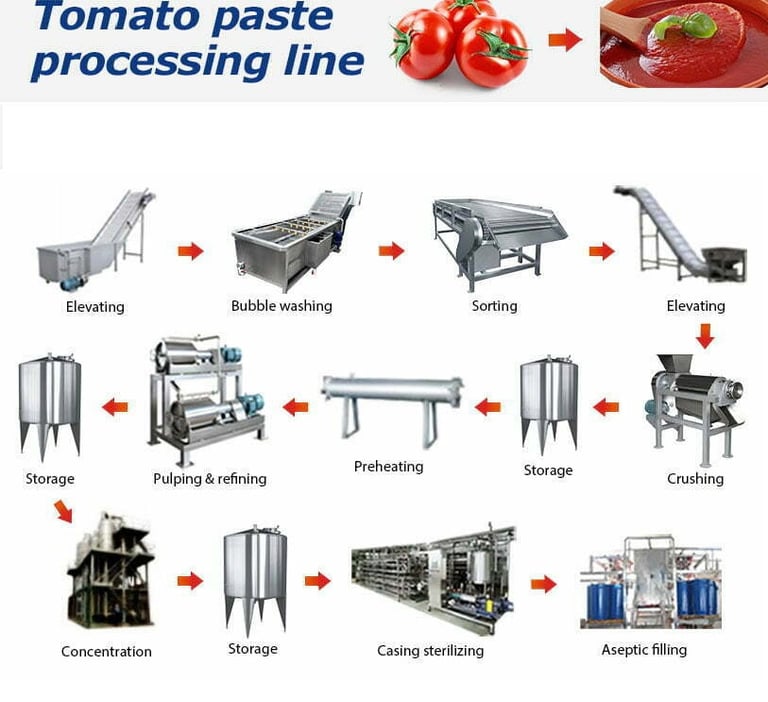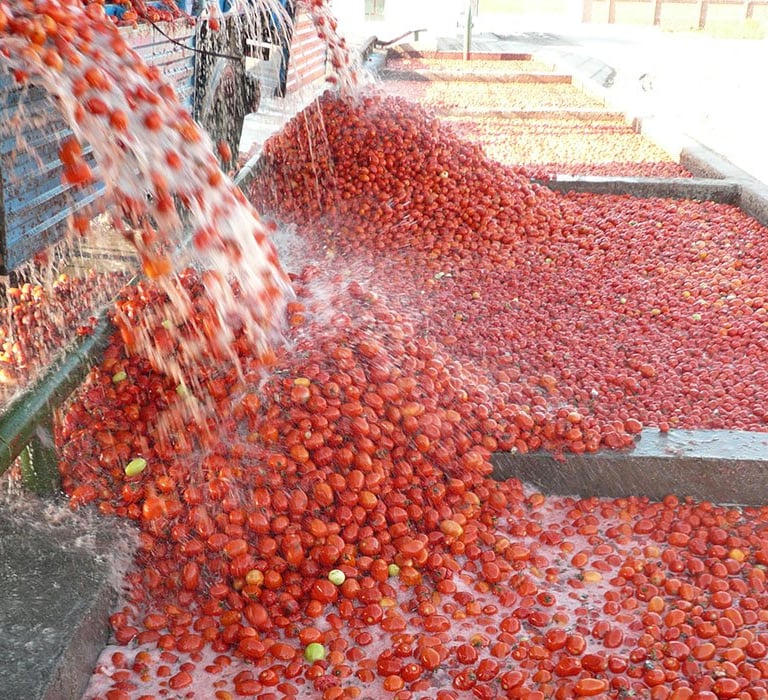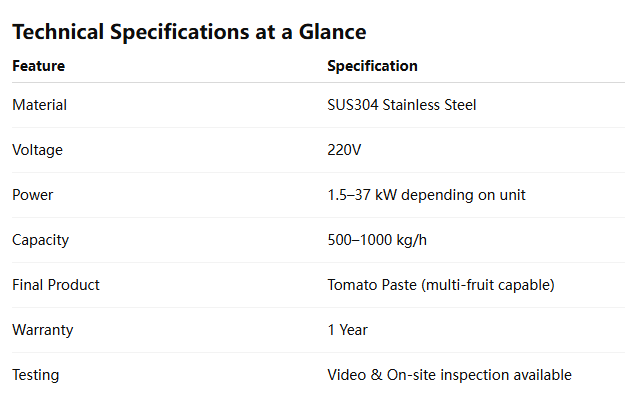From Farm to Jar: The Complete Small-Scale Tomato Processing Line for Premium Paste Production
LEON MACHINERY
8/11/20254 min read


Advantages Over Competing Models
Low-Temperature Evaporation — preserves nutrients & color
Multi-Product Capability — more return on investment
Compact Footprint — fits smaller production spaces
Energy Efficiency — reduces operational costs
Durable Stainless Steel Build — long service life
Conclusion: The Future of Small-Scale Paste Production
LeonMachinery’s line is more than a machine — it’s a gateway to market expansion. Whether you aim for domestic supermarkets, gourmet food stores, or export markets, this system delivers reliability, compliance, and profit potential.
📌 Contact Information
LeonMachinery
📞 WhatsApp: +8618136773114
📧 Email: leonxu0317@gmail.com
#TomatoPasteProduction #FoodProcessingEquipment #LeonMachinery #TomatoProcessing #SmallScaleProduction #FruitProcessing #FoodIndustrySolutions #TomatoPasteLine #IndustrialFoodMachinery #FoodTech




Introduction: A Revolution in Tomato Paste Production
Tomato paste is not just an ingredient. It is the heart of countless recipes — from pasta sauces to soups, from ketchup to gourmet dishes. As global food markets expand and culinary expectations rise, quality tomato paste has become a valuable commodity.
But there’s a problem: traditional large-scale processing lines are expensive, space-consuming, and resource-intensive, often out of reach for small to medium producers. On the other end, purely manual or semi-mechanized processes lack consistency, speed, and compliance with international food safety standards.
Enter LeonMachinery’s Small Scale Tomato Processing Equipment Line — a breakthrough that combines industrial-grade engineering with the agility and affordability needed for small and medium-scale operations. This system is designed to help food entrepreneurs, cooperatives, and regional processors turn fresh produce into market-ready paste, preserving the taste, color, and nutrients that consumers love.
And the beauty? This system doesn’t stop at tomatoes. It can process chili, apple, onion, carrot, strawberry, blackberry, and many other fruits and vegetables — making it a multi-purpose investment for year-round production.
Why Choose a Small-Scale Tomato Processing Line?
The question every business owner asks: why not just buy pre-made paste? The answer lies in control, quality, and profit margins.
Full Control Over Quality
When you own the process, you decide the source of tomatoes, the concentration levels, the sterilization time, and even the packaging. This means zero compromises on taste or nutritional value.Better Profit Margins
Importing paste or buying it from suppliers adds layers of cost. By processing locally, you cut out middlemen and increase profitability.Flexibility in Production
With LeonMachinery’s system, you can switch raw materials to match seasonal availability. In tomato off-season, produce chili paste, carrot puree, or fruit pulp.Compliance and Export Readiness
The equipment is built to international food safety standards, making your paste export-ready for demanding markets in Europe, the Middle East, and North America.Sustainability
Processing locally reduces transportation emissions and supports local farmers — a marketing advantage in today’s eco-conscious market.
Stage One: Fresh Fruit Washing Unit
Every great paste begins with cleanliness. The washing unit ensures that every tomato is free from dust, soil, leaves, and microorganisms before it moves further into production.
A-1 Clapboard Elevator (6T/h)
This elevator gently transfers tomatoes from the receiving pit to the washer. It’s powered by a 2.2 kW motor and an adjustable geared motor that allows speeds between 20–100 RPM, perfect for adapting to different tomato varieties and handling sensitivities.
The anti-corrosion roller chain ensures long-term durability, even in constant wet environments.
A-2 Air-Blow Washer and Sorting Machine (6T/h)
Here’s where the magic of cleanliness happens. Equipped with a stainless steel centrifugal pump and an oxygen pump, this washer removes fine dirt particles while maintaining tomato integrity.
The sorting table, built from stainless steel anti-skid checkered plates, provides a safe surface for workers to manually inspect and remove defective produce.
A-3 Clapboard Elevator (6T/h)
The final transfer to pulping — again using stainless steel construction and controlled speed — ensures no contamination or bruising before the next stage.
💡 Pro Tip: In regions where water usage is restricted, the air-blow washer can be configured with a water recirculation system, reducing waste by up to 40%.
Stage Two: Pulping Unit
The pulping unit is where tomatoes transform from solid fruit into a smooth puree, ready for concentration.
B-1 Crusher
A 6T/h capacity crusher made from SUS304 stainless steel breaks down the tomatoes into manageable pulp. With 18.5 kW power, it easily handles high-yield harvest days.
B-2 Temporary Storage Tank
A 1000 L stainless steel tank temporarily holds the pulp, equipped with CIP (Clean-In-Place) cleaning balls, ensuring that hygiene is never compromised between batches.
B-3 Screw Pump
Transports pulp with minimal damage, maintaining texture. The 0.6 MPa outlet pressure ensures smooth transfer without clogging.
B-4 Tubular Heat Exchanger Heater
This component preheats pulp, helping to inactivate enzymes that could degrade flavor or color. Automatic temperature control guarantees consistency.
B-5 Double Beater
The first mesh (0.8 mm) removes seeds and skins, the second (0.4 mm) produces a fine, silky texture. The 37 kW power ensures steady output even at maximum load.
B-6 Buffer Storage Tank & B-7 Screw Pump
Acts as a pause point before evaporation, giving operators flexibility to adjust production flow.
💡 Case Study: A small tomato cooperative in Turkey reduced manual sorting time by 45% after integrating LeonMachinery’s automated pulping system.
Stage Three: Evaporation and Concentration
This is where flavor intensifies. By reducing water content, the paste achieves the rich thickness consumers expect.
The LeonMachinery system operates at below 70°C, which is critical for preserving Vitamin C, lycopene, and natural pigments.
C-3 Double-Effect Forced Circulation Evaporator
A standout feature — using PLC control for precise temperature, pressure, and flow management. The Spirax Sarco steam pressure system ensures stable heating without overheating.
By working in a double-effect configuration, it saves energy — steam from the first stage powers the second stage, cutting energy costs by up to 30%.
Stage Four: Sterilizing and Filling
At this point, the paste is rich, smooth, and concentrated — but not yet shelf-stable.
D-1 Tube-in-Tube UHT Sterilizer
Sterilizes paste at 110°C for 60 seconds, killing harmful bacteria while keeping flavor and color intact.
D-2 Filling Machine
Accurately fills containers (from small jars to industrial bags) with minimal spillage. Can be adapted for aseptic filling, extending shelf life to over 12 months without preservatives.
💡 ROI Tip: Export markets pay a premium for aseptically packed paste, making this stage a profit booster.
Stage Five: CIP Cleaning System
Hygiene is the foundation of the food industry. The CIP system lets you clean tanks, pumps, and pipelines without disassembly, reducing downtime between production cycles.
With 3000 L tanks for acid, alkali, and hot water, plus an automatic dosing system, it ensures effective cleaning while minimizing chemical use.
